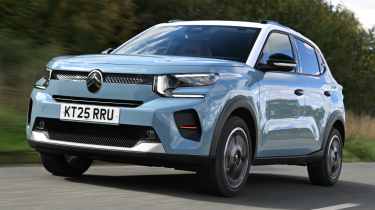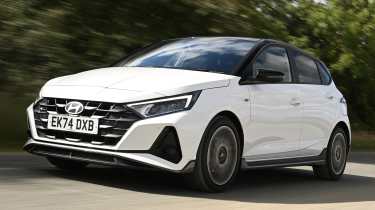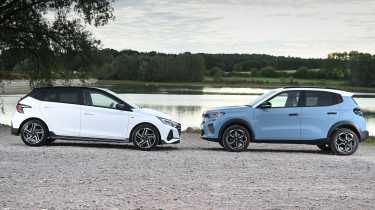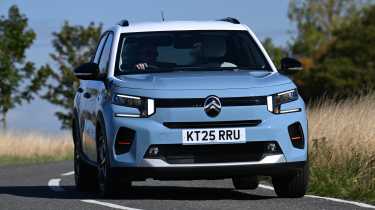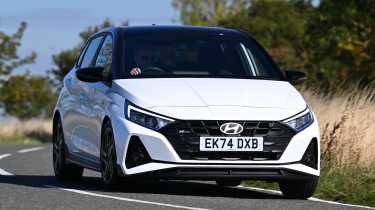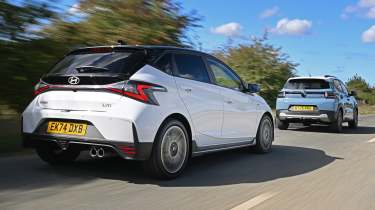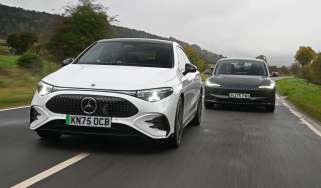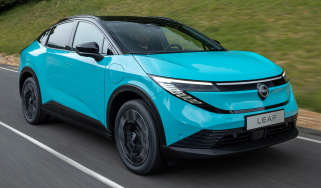Citroen C3 vs Hyundai i20: a stylish supermini showdown
Superminis with auto boxes are more accomplished than ever, but which is the better self-shifter – Citroen’s C3 or Hyundai’s i20?
Recent Driver and Vehicle Standards Agency (DVSA) data revealed that more than a quarter of young drivers took their driving tests in automatic cars, compared with around seven per cent just 10 years ago.
Some will put this down to the increasing number of electric vehicles on the used-car market – making the need to use three pedals far less vital than even a few years ago. But we’d also attribute it to the fact that automatics are so much better than they used to be.
Driving an auto, especially around town, is just so much easier than rowing through a manual gearbox while balancing a clutch pedal. So why make life hard for yourself?
Here, we’re testing one of the superminis of the moment, which is available both as a fully electric car and as a petrol hybrid with an automatic gearbox. In electric form the Citroen C3 proved that EVs needn’t be expensive to buy, but in two-pedal hybrid guise it requires even less cash.
To find out how well it fares, we’re pitching it against the Hyundai i20. We know there’s plenty to like here, and the i20 is available with a dual-clutch transmission, so we’ll look to see how that compares to the Citroen’s tech.
Used - available now

2025 Audi
A5
10,803 milesAutomaticPetrol2.0L
Cash £24,497
2023 Polestar
2
31,857 milesAutomaticElectric
Cash £21,676
2018 Lexus
IS
75,017 milesAutomaticPetrol2.5L
Cash £16,245
2017 Kia
Carens
102,355 milesManualPetrol1.6L
Cash £6,627Did you know you can sell your car through Auto Express? We’ll help you get a great price and find a great deal on a new car, too.
Citroen C3
| Model: | Citroen C3 Hybrid Max |
| Price: | £22,315 |
| Powertrain: | 3cyl inline/1,199cc |
| 0-62mph: | 9.8 seconds |
| Test efficiency: | 50.1mpg |
| Official range: | 485 miles |
| Annual VED: | £195 |
We named the electric e-C3 our 2024 Car of the Year, with Citroen offering buyers a spacious, likeable small EV that turned out to be something of a bargain. However, the petrol and hybrid versions are even cheaper. The petrol C3 starts from £18,805, which undercuts much of the supermini competition – and as a bonus its boxy shape offers loads of cabin space. The car we’re testing here comes with a hybrid powertrain, which is available only in top-spec Max trim. It costs £22,315.
Tester’s notes
Brake-regeneration technology is a no-brainer for hybrids, because it helps to eke out even more efficiency for the petrol/electric system. However, I found that it doesn’t take too much brake regeneration for the C3’s system to decide that the brake lights need to be activated.
I could spot a reflection of the high-level brake light flickering on and off in the boot, even during gentle deceleration. If I was following a car with the brake light flickering so regularly, I’d suspect that I was sitting behind a nervous driver.
Citroen models have always been known for their ergonomic quirks, so finding that the C3 has some of its own comes as no surprise. Those familiar with Stellantis products might already know that a little button on the end of the wiper stalk works the trip computer – but we’d be impressed if anyone else ever finds it here. Not only is the button unlabelled, but there’s also a logo for the rear wiper control beside it. More confusingly, all the other trip controls are on the steering wheel itself.
Hyundai i20
| Model: | Hyundai i20 DCT Advance |
| Price: | £23,350 |
| Powertrain: | 3cyl inline/998cc |
| 0-62mph: | 12.1 seconds |
| Test efficiency: | 49.6mpg |
| Official range: | 436 miles |
| Annual VED: | £195 |
The current i20 has always been there or thereabouts in the supermini pecking order. Its first Auto Express group test saw it beat the Volkswagen Polo and SEAT Ibiza, but in early 2024 it narrowly lost to the Vauxhall Corsa – a sloppy manual gearbox and high price were to blame.
The car we’re driving here is the sporty-looking N-Line S auto, which costs £26,000. But the specs and figures we’re using are for the base Advance model, which has a £23,350 price tag that is much closer to the C3’s.
Tester’s notes
It’s a huge shame that the simply brilliant i20 N hot hatchback is no longer available. While the recently released N-Line S certainly doesn’t have the N’s performance credentials, it does get sporty wheels and styling add-ons to at least give a hint of the outgoing performance hatch’s looks.
Most surprisingly of all, it even offers some of the sound. Those twin tailpipes emit an amusing burble both at idle and during hard acceleration, giving the N-Line S more character than many proper hot hatches on the market now.
Sometimes, choosing a pick of the range is easier said than done – but for the i20 it’s a no-brainer. The entry-level Advance is so well equipped for a supermini, the majority of buyers will be satisfied putting their money there. The only thing we think it lacks compared with the latest competition is wireless Apple CarPlay and Android Auto; both are available with a wired connection, albeit through an infotainment system that is surprisingly fussy about the sort of USB cable it will accept.
Head-to-head
On the road
The C3’s suspension is set up for comfort. This soft arrangement makes it very relaxing to drive on open roads and motorways, but on twistier country highways it can bounce around a little clumsily, to the point where driver and passengers will find the firmer i20 more reassuring. Both models have a slightly fidgety low-speed ride, but the i20 is better at isolating the sound of bumps and knocks from its occupants.
Tech highlights
Both cars have a three-cylinder petrol engine and a six-speed dual-clutch auto transmission, but the C3’s unit has 200cc of extra capacity plus a hybrid boost from a small electric motor. This lets the C3 cover some town driving on electric power alone, making it smooth and quiet at low speeds. It has stronger performance than the i20 on faster roads, too. However, the Hyundai’s gearbox shifts faster and more smoothly.
Price and running
Despite the C3’s hybrid tech, the difference in fuel efficiency with this pair is hardly night and day. We averaged just over 50mpg during our time with the Citroen, and just under 50mpg in the Hyundai, so differences in running costs are tiny. However, the C3 is better value for money; its top-spec Max trim, even with the car’s extra size and hybrid kit, costs just over £1,000 less than the i20 auto in base Advance trim.
Practicality
The C3 is taller than most typical superminis – and even some supermini-sized SUVs – so it’s really spacious inside. Rear headroom is its biggest strength, but rear knee room and foot space are also plentiful, and the seats are very soft. The i20 matches the C3 for knee room, but is a little behind in other areas. The Hyundai’s boot is a close match for its rival’s, and an adjustable floor makes the space more versatile.
Safety
While the C3 hasn’t been tested by Euro NCAP yet, the Max trim is fairly well furnished with active safety-assist systems, including lane- keep assist, cruise control, speed-limit information and driver-attention alert. It has six airbags as standard. The i20 achieved a four-star rating when it was tested in 2021. All i20s get rear parking sensors and lane-keep assist, although we found the latter to be a little over-zealous.
Ownership
Both brands scored slightly below-average rankings in our 2025 Driver Power customer satisfaction survey, with Citroen taking 16th place (out of 31) and Hyundai 20th. But Hyundai offers a five-year, 100,000- mile warranty. That looks stronger than Citroen’s standard three-year deal, but owners who follow the C3’s service schedule at an authorised dealer will see their cover run for as long as eight years.
Verdict
Winner: Citroen C3
The C3 feels like Citroen is getting back to doing what it knows best: small, comfortable cars that are low on pretentiousness, but high on value. This chunky supermini is among the most spacious options on the market, with loads of interior space that makes it a good choice for families.
Sometimes its soft suspension can work against it – it can get a little too bouncy over big bumps, and the steering is vague – yet it still manages to deliver a unique focus on comfort in this segment. The fact it offers all this at a price that undercuts most alternatives is what really seals the win here.
Runner-up: Hyundai i20
The i20 has always been among our very favourite models in this class, and although it still definitely impresses in some areas, in others it’s unfortunately starting to show its age. The cabin is spacious and equipment levels are strong, while the latest N-Line S trim adds a characterful new option at the top of the range.
Ride, handling and steering are very well judged, too. However, the single engine option lacks meaningful power and the infotainment system feels slow and clunky. For the money, it doesn’t appear that the i20 is offering particularly strong value.
Prices and specs
| Our choice | Citroen C3 Hybrid Max | Hyundai i20 DCT Advance |
| Price of our choice/as tested | £22,315/£22,315 | £23,350/£26,000 |
| Powertrain and performance | ||
| Engine | 3cyl inline/1,199cc | 3cyl inline/998cc |
| HEV Motor | 28bhp | N/A |
| Power | 109bhp | 99bhp |
| Torque | 205Nm | 200Nm |
| Transmission | Six-speed auto/fwd | Seven-speed auto/fwd |
| 0-62mph/top speed | 9.8 secs/99mph | 12.1 secs/112mph |
| Fuel tank capacity | 44 litres | 40 litres |
| MPG (test/WLTP)/range | 50.1/56.5mpg/485 miles | 49.6/52.3mpg/436 miles |
| CO2 | 114g/km | 122g/km |
| Dimensions | ||
| Length/wheelbase | 4,015/2,540mm | 4,065/2,580mm |
| Width/height | 1,813/1,577mm | 1,775/1,450mm |
| Rear knee room | 605-845mm | 570-795mm |
| Rear headroom/elbow room | 955/1,405mm | 924/1,442mm |
| Boot space (seats up/down) | 310/1,188 litres | 352/1,165 litres |
| Boot length/width | 731/1,000mm | 610/1,041mm |
| Boot lip height | 785mm | 713mm |
| Kerbweight/towing weight | 1,252/600kg | 1,090/1,110kg |
| Turning circle | 10.9 metres | 10.4 metres |
| Costs/ownership | ||
| Residual value (after 3yrs/36,000 miles) | £10,100/45.3% | £12,220/47.0% |
| Depreciation | £12,215 | £11,130 |
| Ins. group/quote/VED | 24/£606/£195 | 14/£512/£195 |
| Three-year service cost | £674 | £676 |
| Annual tax liability std/higher rate | £1,210/£2,419 | £1,371/£2,743 |
| Fuel cost (10,000 miles) | £1,225 | £1,237 |
| Basic warranty (miles)/recovery | 3yrs (60,000)/1yr | 5yrs (unlimited)/1yr |
| Driver Power manufacturer position | 16th | 20th |
| NCAP Adult/child/ped./assist/stars | Not yet tested | 76/82/76/67/4_ (2021) |
| Equipment | ||
| Metallic paint/wheel size | £645/17-inch | £600/16-inch |
| Parking sensors/camera | Rear/yes | Rear/yes |
| Spare wheel/Isofix points | No/two | Repair kit/two |
| Keyless entry & go/powered tailgate | No/no | No/no |
| Leather/heated seats | No/yes | No/no |
| Screen size/digital dashboard | 10.25-inch/yes | 10.25-inch/yes |
| Climate control/panoramic sunroof | Yes/no | Yes/no |
| USBs/wireless charging | Four/yes | Three/no |
| Wireless CarPlay/Android Auto | Yes/yes | Wired |
| Blind-spot warning/head-up display | No/no | No/no |
| Adaptive cruise/steering assist | No/no | No/no |
What we would choose
Citroen C3
Beyond the six exterior paint colours, the only Citroen C3 option is something that should really just be included as standard anyway. With no spare wheel available, charging £20 for a puncture-repair kit and compressor is a little stingy.
Hyundai i20
Hyundai doesn’t really ‘do’ options on many of its new cars, so beyond the eight paint options, the only extras here come in the form of colourful steering wheel inlays, rear-seat ambient lighting and exterior racing stripes.
Looking for your next car? You can now search our nationwide dealer network for a choice of great cars on offer right now with new, used and leasing deals to choose from...

